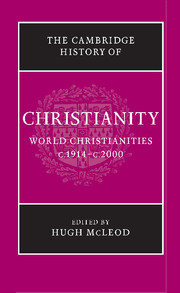Book contents
- Frontmatter
- 1 Introduction
- 2 Being a Christian in the early twentieth century
- PART I INSTITUTIONS AND MOVEMENTS
- PART II NARRATIVES OF CHANGE
- 8 The Great War
- 9 The Christian churches and politics in Europe, 1914–1939
- 10 Latin America, c.1914–c.1950
- 11 African Christianity: from the world wars to decolonisation
- 12 The African diaspora in the Caribbean and Europe from pre-emancipation to the present day
- 13 Christianity in the United States during the inter-war years
- 14 Christian churches in Australia, New Zealand and the Pacific, 1914–1970
- 15 Catholicism and Protestantism in the Second World War in Europe
- 16 The Cold War, the hegemony of the United States and the golden age of Christian democracy
- 17 The religious ferment of the sixties
- 18 The crisis of Christianity in the West: etering a post-Christian era?
- 19 The revolutions in eastern Europe and the beginnings of the post-communist era
- 20 The transformation of Latin American Christianity, c.1950–2000
- 21 Religion and racism: struggles around segregation, ‘Jim Crow’ and apartheid
- 22 Post-colonial Christianity in Africa
- 23 South Asia, 1911–2003
- 24 Christianity in South-East Asia, 1914–2000
- 25 East Asia
- PART III SOCIAL AND CULTURAL IMPACT
- Bibliography
- Index
- References
10 - Latin America, c.1914–c.1950
from PART II - NARRATIVES OF CHANGE
Published online by Cambridge University Press: 28 March 2008
- Frontmatter
- 1 Introduction
- 2 Being a Christian in the early twentieth century
- PART I INSTITUTIONS AND MOVEMENTS
- PART II NARRATIVES OF CHANGE
- 8 The Great War
- 9 The Christian churches and politics in Europe, 1914–1939
- 10 Latin America, c.1914–c.1950
- 11 African Christianity: from the world wars to decolonisation
- 12 The African diaspora in the Caribbean and Europe from pre-emancipation to the present day
- 13 Christianity in the United States during the inter-war years
- 14 Christian churches in Australia, New Zealand and the Pacific, 1914–1970
- 15 Catholicism and Protestantism in the Second World War in Europe
- 16 The Cold War, the hegemony of the United States and the golden age of Christian democracy
- 17 The religious ferment of the sixties
- 18 The crisis of Christianity in the West: etering a post-Christian era?
- 19 The revolutions in eastern Europe and the beginnings of the post-communist era
- 20 The transformation of Latin American Christianity, c.1950–2000
- 21 Religion and racism: struggles around segregation, ‘Jim Crow’ and apartheid
- 22 Post-colonial Christianity in Africa
- 23 South Asia, 1911–2003
- 24 Christianity in South-East Asia, 1914–2000
- 25 East Asia
- PART III SOCIAL AND CULTURAL IMPACT
- Bibliography
- Index
- References
Summary
Around 1914 Latin America was widely understood to be a Catholic continent, and Catholic propagandists depicted it as the beneficiary of sustained missionary endeavour during the colonial period. This orthodoxy seemed confirmed by national censuses, which routinely identified over 90 per cent of the populations of various countries as Catholic. Protestant missionaries, reaffirming these simplicities, viewed themselves as championing a heroic struggle against ‘Romish domination’. The reality was different: more subtle, diverse and complex. The spatial impact of the Catholic church was never uniform, being more pronounced in upland areas of relatively dense settlement than in the more sparsely inhabited lowlands. The social significance of the Catholic church varied considerably between and within social classes and ethnic groups. Profound and nominal commitment, indifference, suspicion and unalloyed hostility were all observed. The political influence of Catholicism varied by nation, region and municipality, according to specific experiences of regalism, independence and civil war, and the impact of secularising ideologies. The direction of change in Christianity across Latin America over the first half of the twentieth century was broadly the same, but its pace was never uniform. Domestic trends interacted with external influences to produce a richly heterogeneous picture, which often defies generalisation. Thus the record of the Catholic church in catechisation was patchy, as was its distribution of institutional resources. The limits to formal Catholic influence were observed in low rates of church marriage over vast areas. In many dioceses more effort was invested by the bishops in obstructing legislation for civil marriage and divorce that interested small minorities than in assuring effective ratios of clergy to parishioners.
- Type
- Chapter
- Information
- The Cambridge History of Christianity , pp. 179 - 196Publisher: Cambridge University PressPrint publication year: 2006



